To keep your dried herbs mold-free, focus on proper storage techniques. Use airtight containers made of glass or ceramic to prevent moisture and air exposure. Store them in a cool, dark place away from sunlight and heat sources, and ascertain containers are tightly sealed. Regularly check for signs of moisture, like sticky textures or unusual odors, and discard any affected herbs. Label each container with the herb name and purchase date for easy tracking. Following these tips will help maintain their flavor and potency over time, but there's plenty more you can learn about enhancing your herb storage.
Importance of Proper Storage
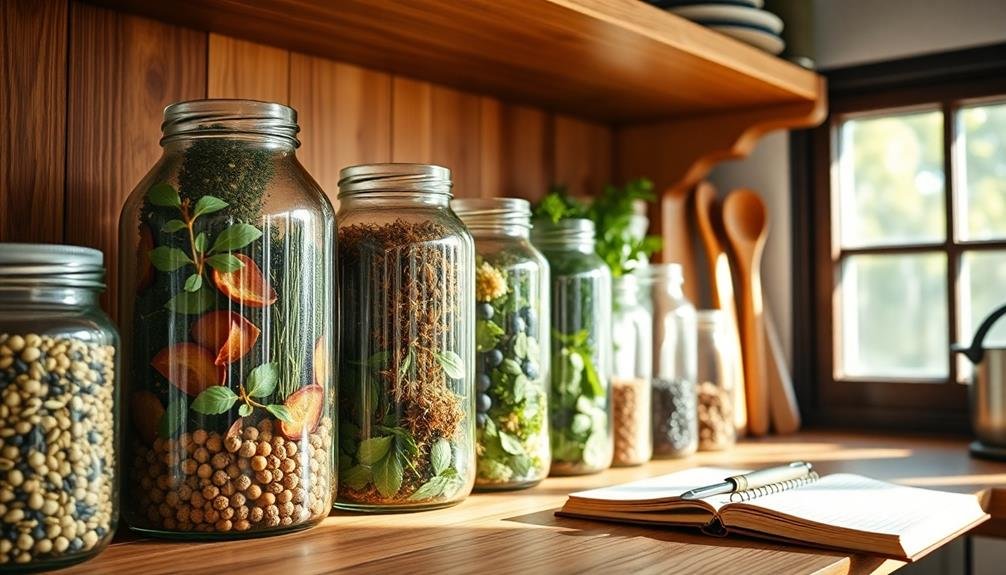
While you might think dried herbs can simply be tossed in a cupboard, proper storage is vital for maintaining their flavor and potency. When herbs are exposed to air, light, and moisture, they lose their aromatic qualities and health benefits over time. Keeping them in an ideal environment guarantees they remain vibrant and effective in your cooking.
First, consider temperature control. Heat can break down essential oils, leading to flavor loss. Store your herbs in a cool, dark place, away from stoves and direct sunlight. Avoid placing them near sources of humidity, like dishwashers or sinks, as moisture can encourage mold growth and spoilage.
You should also think about air exposure. Once you open a package of dried herbs, oxidation begins. Seal them tightly after each use to limit their contact with air. Using airtight containers can greatly extend their shelf life.
Lastly, always check for signs of spoilage, like changes in color or odor. Proper storage not only helps preserve your herbs but also enhances your culinary creations, allowing you to enjoy their full potential in every dish.
Choosing the Right Containers
When it comes to storing dried herbs, choosing the right container is essential.
You need an airtight seal to keep your herbs fresh, and the material can affect their flavor and potency.
Plus, considering the size and shape of the container will help you maximize your storage space and accessibility.
Airtight Seal Importance
Choosing the right containers for your dried herbs is essential to maintaining their flavor and potency. One of the most critical features to look for is an airtight seal. An airtight container prevents air from seeping in, which can lead to moisture buildup and, ultimately, mold growth.
Without that seal, your herbs are exposed to humidity, which can ruin their quality. When selecting containers, consider options that provide a secure closure, like glass jars with tight lids or vacuum-sealed bags.
These options not only keep air out but also protect your herbs from light, which can diminish their color and aroma over time. Keep in mind that even small gaps can compromise the integrity of your herbs, so always check that the seal is intact before storing them.
If you notice any signs of wear or damage, it's best to replace the container.
Material Matters
The right container material can make a significant difference in preserving the freshness of your dried herbs. When choosing a container, opt for glass, ceramic, or food-grade stainless steel. These materials are non-reactive and won't leach chemicals into your herbs, guaranteeing they remain pure and flavorful.
Avoid plastic containers, as they can trap moisture and odors, leading to potential mold growth. If you do use plastic, make sure it's high-quality and specifically designed for food storage. However, glass is your best bet for long-term storage. Not only is it airtight, but it also protects your herbs from light, which can degrade their quality.
Consider using dark glass containers, like amber or cobalt, to further shield your herbs from UV rays. This extra layer of protection helps maintain potency and aroma. When you store your herbs, guarantee the container has a tight-fitting lid to keep out moisture and air.
Lastly, keep your containers in a cool, dark place, away from heat sources. With the right materials, you can extend the shelf life of your dried herbs and enjoy their vibrant flavors for months to come.
Size and Shape
Container size and shape play a significant role in how well your dried herbs are stored. You want to choose containers that are appropriately sized for the amount of herbs you have. If your container is too large, excess air can lead to moisture buildup and spoilage. On the other hand, if it's too small, you might end up crushing the herbs, which can diminish their flavor and potency.
Opt for containers that are narrow and tall rather than wide and short. This shape minimizes the surface area exposed to air, reducing the risk of moisture getting in. Glass jars with tight-fitting lids are ideal, as they provide an airtight seal and protect your herbs from light.
If you have a variety of herbs, consider using small, labeled jars for each type. This way, you can easily find what you need without exposing the rest to air and light.
Remember to store your containers in a cool, dark place, away from heat sources and humidity. By selecting the right size and shape, you'll guarantee your dried herbs stay fresh and flavorful for longer.
Ideal Storage Locations
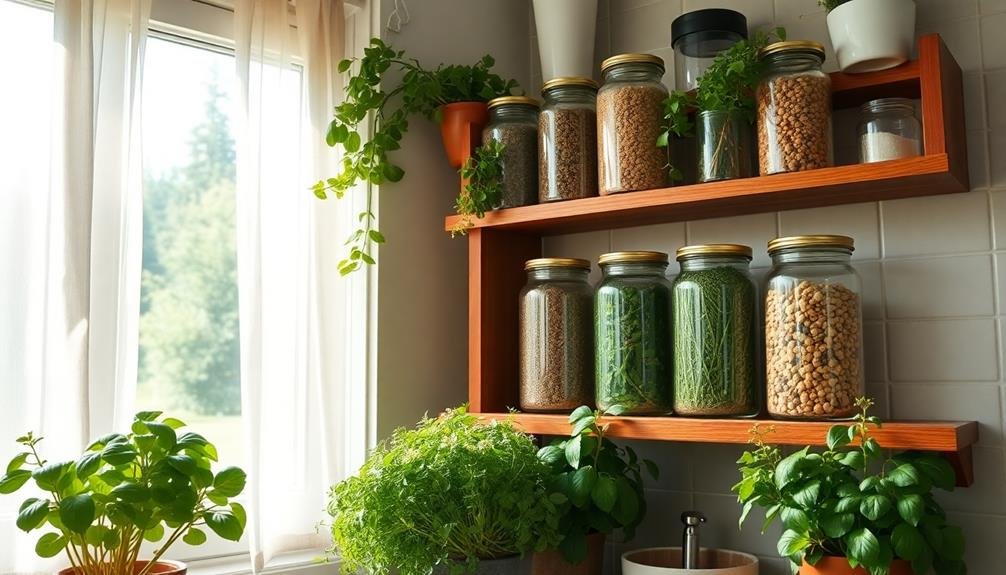
Often overlooked, the location where you store your dried herbs plays an essential role in maintaining their flavor and potency. Choose a cool, dark place away from direct sunlight. Light can degrade the quality of your herbs over time, sapping their vibrant flavors and aromas. A kitchen pantry or a cupboard works well, as long as it's not near the stove, which can generate heat and humidity.
Avoid storing your herbs in the refrigerator or freezer. While it might seem like a good idea to keep them cold, the constant temperature fluctuations can introduce moisture, leading to mold growth. Instead, opt for airtight containers that shield your herbs from air and light. Glass jars, metal tins, or dark-colored containers are excellent choices.
Keep your dried herbs away from sources of moisture, like sinks or dishwashers. Moisture can ruin your herbs faster than you might think.
It's also helpful to designate a specific shelf or area in your kitchen for your herb collection, so they're easy to access and less likely to be forgotten. By taking these steps, you'll preserve the quality of your dried herbs for flavorful meals ahead.
Maintaining Optimal Humidity
Humidity is an essential factor in preserving the quality of your dried herbs. Too much moisture can lead to mold growth, while too little can cause your herbs to lose flavor and aroma. To maintain ideal humidity, you should store your herbs in airtight containers. Glass jars or vacuum-sealed bags work well, as they keep moisture out and protect your herbs from environmental fluctuations.
You should also consider using desiccants, like silica gel packets, to absorb excess moisture inside the storage containers. Just be sure to place them in a way that doesn't come into direct contact with your herbs.
Keep your containers in a cool, dark place, away from heat sources, which can increase humidity levels. Regularly check your herbs for any signs of moisture or mold. If you notice any clumping or unusual odors, it's best to discard those herbs to avoid contaminating the others.
Temperature Control Techniques
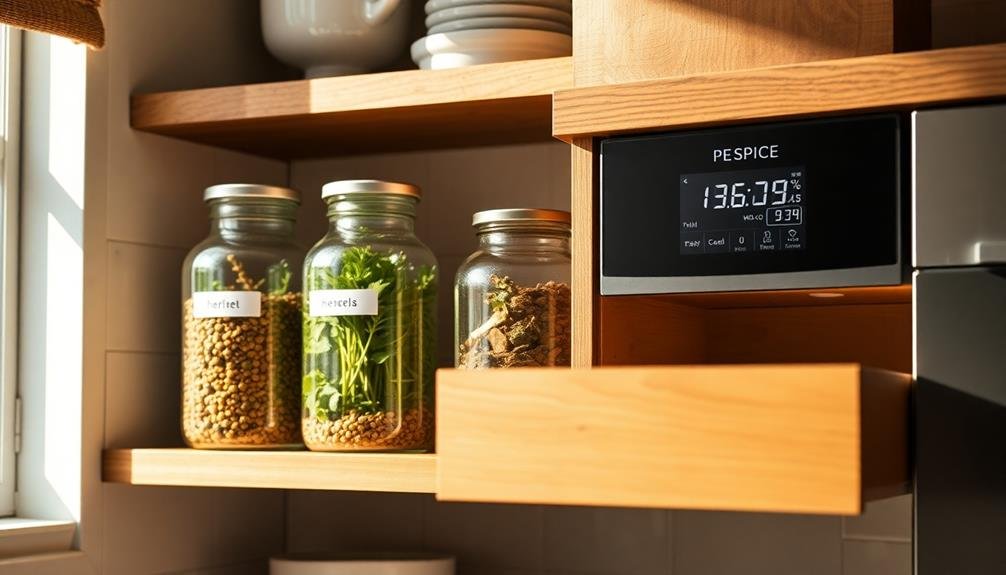
To keep your dried herbs fresh, it's essential to store them at the right temperatures.
Aim for a cool, dark place, as heat can degrade their flavor and potency.
Additionally, be mindful of humidity exposure, as it can lead to mold growth and spoilage.
Ideal Storage Temperatures
Maintaining the right temperature is vital for preserving the flavor and potency of dried herbs. Storing your herbs at an ideal temperature helps prevent degradation and guarantees you get the most out of their unique qualities. Ideally, you should keep your dried herbs in a cool, dark place, away from heat sources like stoves or ovens.
To help you understand the perfect temperature ranges for your herbs, here's a quick reference table:
| Herb Type | Ideal Temperature (°F) |
|---|---|
| Leafy Herbs | 60 – 70 |
| Spicy Herbs | 60 – 70 |
| Woody Herbs | 60 – 75 |
| Seeds & Barks | 65 – 75 |
| Roots | 65 – 75 |
As you can see, most herbs thrive in a temperature range between 60°F and 75°F. If you can maintain this environment, you'll preserve the oils and flavors that make your dried herbs so special. Remember, choosing the right storage location is just as important as the herbs themselves, so keep an eye on those temperatures!
Avoiding Humidity Exposure
Exposing dried herbs to moisture can greatly diminish their flavor and aroma, so it's important to keep them in a dry environment. One effective way to avoid humidity exposure is by storing your herbs in airtight containers. Glass jars with tight-fitting lids or vacuum-sealed bags work best to prevent moisture from seeping in.
Additionally, consider the location of your storage. Avoid placing your herbs near the stove, sink, or any damp areas. Instead, opt for a cool, dark cupboard or pantry. Temperature fluctuations can introduce moisture, so try to maintain a consistent environment.
If you live in a particularly humid area, using silica gel packets in your storage containers can help absorb excess moisture. Just remember to replace them periodically.
Lastly, never store your dried herbs in the refrigerator. The cool environment may seem ideal, but the humidity inside can lead to mold growth. Stick to a dry, room-temperature space, and your herbs will thank you with a longer shelf life and enhanced flavor.
Light Exposure Considerations
Light is a silent enemy when it comes to storing dried herbs. It can degrade their quality, robbing you of flavor and potency. To keep your herbs vibrant and effective, it's essential to minimize light exposure.
Here are some key considerations to keep in mind:
- Choose Dark Containers: Opt for amber or dark-colored glass jars that block light. This simple choice can greatly extend your herbs' lifespan.
- Store in a Dark Place: Keep your herbs in a cupboard or pantry, away from direct sunlight. Even the best containers won't fully protect your herbs if they're exposed to light.
- Avoid Clear Containers: While clear jars may look pretty, they invite light in. Resist the temptation and stick with opaque options.
- Seal Tightly: Make sure your containers are tightly sealed to further safeguard against light and air exposure. This extra layer of protection helps maintain freshness.
Checking for Moisture
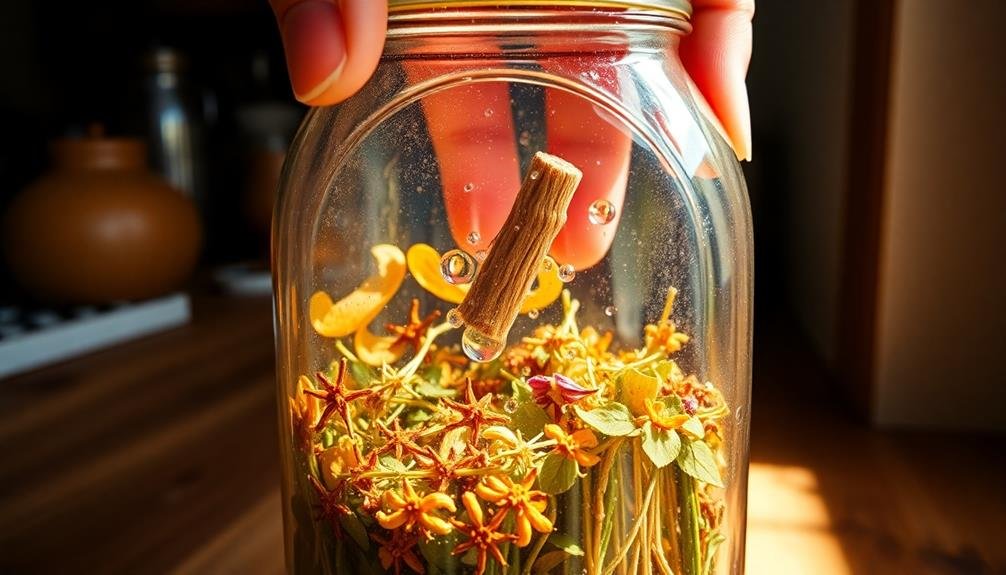
When it comes to storing dried herbs, checking for moisture is essential. Moisture is the enemy of dried herbs, as it can lead to mold growth and spoilage. To guarantee your herbs stay fresh, you should regularly inspect them for any signs of dampness.
Start by feeling the herbs with your fingers; they should feel dry and crumbly. If they feel sticky or soft, it's a red flag that moisture might be present.
Next, take a closer look at the storage container. If you notice condensation on the inside of the jar or bag, it's time to address it. You might want to transfer your herbs to a new, dry container.
Also, consider using airtight containers made of glass or plastic that can help keep moisture out.
If you've recently harvested your herbs, allow them to dry completely before storing them. You can hang them upside down in a well-ventilated area away from sunlight.
Avoiding Contamination
Moisture isn't the only factor you need to watch out for; contamination can also compromise the quality of your dried herbs. Ensuring your herbs stay pure and flavorful requires attention to detail.
Here are some key steps to avoid contamination:
- Keep them sealed: Use airtight containers to protect your herbs from dust, dirt, and pests. This simple step can greatly extend their shelf life.
- Avoid cross-contamination: When using your herbs, always make sure your utensils are clean. A single touch with an unclean spoon can introduce bacteria that spoil your herbs.
- Store separately: If you're using different herbs, keep them in separate containers to prevent flavor mingling and contamination. This way, each herb retains its unique qualities.
- Beware of the kitchen environment: Be mindful of where you store your herbs. Avoid placing them near the stove or sink, where they may be exposed to steam and spills.
Labeling for Freshness
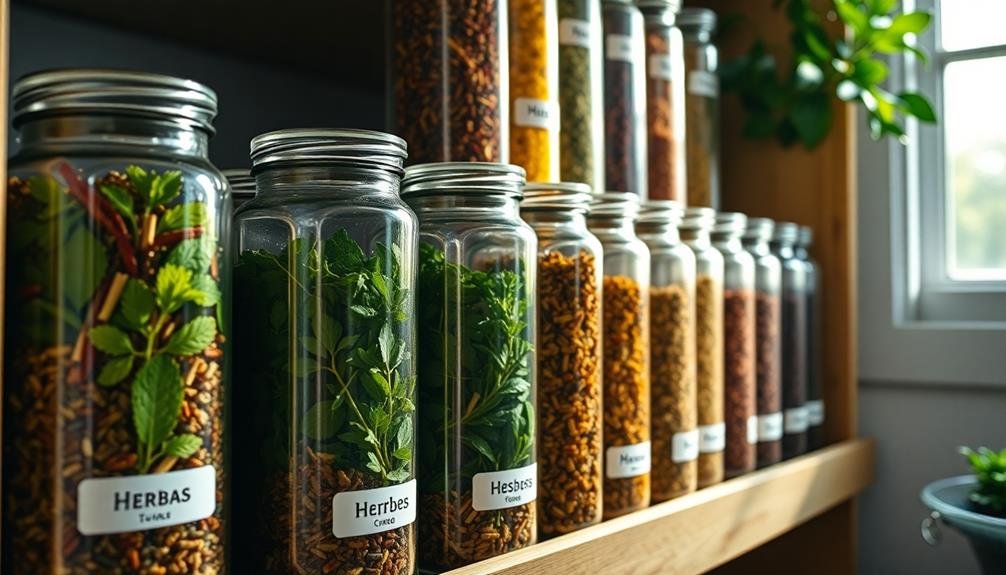
Keeping track of your dried herbs' freshness can be a challenge, but labeling them can make it a breeze. Start by using clear, waterproof labels that can withstand varying temperatures and moisture levels. Write the name of the herb and the date it was dried or purchased. This way, you'll always know how long it's been since they were harvested.
When you label, be consistent. Choose a specific format for all your herbs, whether it's the date first or the name first. This consistency helps you quickly assess your collection at a glance.
Consider also using color-coded labels for easy identification; for instance, green for basil, red for chili flakes, and so on.
You might also want to include usage tips on the labels, like the best dishes for each herb or how to use them fresh. This makes cooking easier and encourages you to use your dried herbs before they lose flavor.
Regularly check your labels and update them as needed. Keeping your herbs organized and properly labeled not only enhances your cooking experience but helps prevent spoilage, ensuring you enjoy the best flavors in your dishes.
Duration of Storage
Understanding how long you can store dried herbs is essential for maintaining their flavor and potency. Generally, dried herbs can last anywhere from six months to three years, depending on the type of herb and how you store them.
To make the most of your dried herbs, keep these key durations in mind:
- Delicate Herbs: Basil, parsley, and dill typically last about six months, so use them quickly for the best flavor.
- Hardy Herbs: Oregano, thyme, and rosemary can last up to a year, retaining their taste longer than delicate varieties.
- Root and Seed Herbs: Herbs like ginger and mustard seeds have a shelf life of up to three years, making them excellent long-term options.
- Storage Conditions: Storing your herbs in a cool, dark place can extend their life, ensuring you enjoy their full flavor.
Signs of Mold Growth
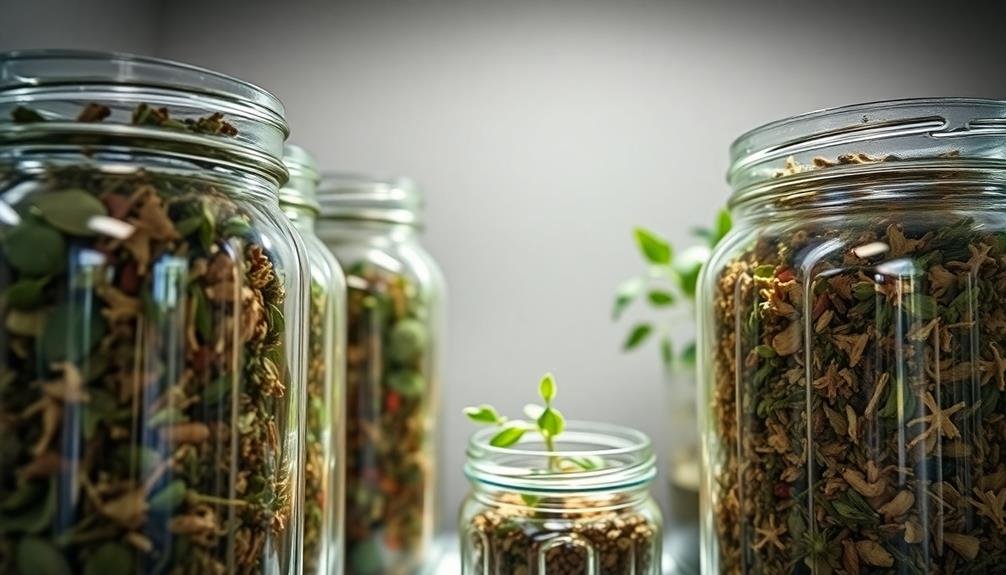
When it comes to dried herbs, being vigilant about signs of mold growth is vital for maintaining their safety and quality. Mold can thrive in damp environments, so it's important to inspect your herbs regularly. Look for any unusual discoloration, such as dark spots or fuzzy patches, particularly in areas that feel damp. If you notice any of these signs, it's a clear indication that your herbs may be contaminated.
Additionally, pay attention to the smell of your dried herbs. They should have a rich, aromatic scent. If you detect a musty or off odor, it could signal mold presence. You should also check the texture; if the herbs feel slimy or overly moist, it's a red flag.
Furthermore, be cautious about clumping. If your herbs are sticking together or forming lumps, moisture might be trapped, leading to potential mold growth. Always store your herbs in airtight containers to prevent excess humidity.
Reviving Dried Herbs
If your dried herbs have lost their potency, you can easily revive them with a few effective methods.
By rehydrating them properly, you'll enhance their flavor profiles and bring dishes back to life.
Plus, knowing the best storage techniques will help keep those flavors vibrant for longer.
Best Rehydration Methods
Reviving dried herbs can breathe new life into your dishes, enhancing flavors and aromas. You don't have to settle for lifeless spices; with the right rehydration methods, your dried herbs can regain their vibrancy.
Here are four effective ways to bring your herbs back to life:
- Soaking in Water: Place your dried herbs in a bowl of warm water for about 10-15 minutes. This method works well for delicate herbs, allowing them to absorb moisture and regain their original texture.
- Steam Infusion: Add dried herbs to a steaming pot of vegetables or grains. The steam will gently rehydrate the herbs while infusing their flavor into the dish.
- Quick Sauté: Heat a little oil in a pan and toss in your dried herbs for a minute or two. This quick method helps release their essential oils and enhances their aroma.
- Broth or Stock: Incorporate dried herbs directly into your soups or stews. As they simmer, they'll rehydrate and contribute their flavor to the entire dish.
With these methods, you'll elevate your cooking and guarantee your dried herbs shine again!
Enhancing Flavor Profiles
Dried herbs can transform your cooking, but their full potential often lies dormant until you know how to enhance their flavor profiles. To truly awaken those flavors, start by crushing or grinding the herbs just before use. This releases essential oils and compounds that contribute to their aroma and taste, making your dishes more vibrant.
Another effective technique is to bloom your herbs. By adding them to hot oil or liquid at the beginning of cooking, you allow their flavors to infuse the dish right from the start. For example, sautéing dried oregano in olive oil before adding your tomatoes creates a rich base for sauces.
Consider pairing your dried herbs with complementary ingredients. Mixing rosemary with garlic or thyme with lemon can elevate your dishes to new heights. If you're experimenting with spice blends, be mindful of the balance—too much of one herb can overpower the others.
Lastly, don't forget about steeping your dried herbs in warm water to create flavorful teas or broths. This method can be a fantastic way to extract their essence, giving you a concentrated flavor boost.
Proper Storage Techniques
To keep your dried herbs flavorful and aromatic, proper storage techniques are essential. You want to guarantee that your herbs maintain their potency for as long as possible, and that starts with how you store them.
Here are four key storage tips to revive and preserve your dried herbs:
- Use Airtight Containers: Choose glass jars or containers with tight-fitting lids. This keeps moisture and air out, preventing mold and loss of flavor.
- Keep Them Cool and Dark: Store your herbs in a cool, dark place away from direct sunlight. Light and heat can degrade the quality of your herbs over time.
- Avoid Humidity: Don't store your herbs near the stove or sink. Humidity can cause clumping and spoilage, so find a dry, stable location.
- Label and Date: Always label your containers with the herb's name and the date you dried them. This helps you keep track of freshness and guarantees you use them in their prime.
Frequently Asked Questions
Can I Freeze Dried Herbs for Longer Storage?
You can freeze dried herbs, but it's generally unnecessary. They're already dehydrated for long-term storage. If you choose to freeze them, make certain they're in airtight containers to prevent moisture and preserve their flavor.
How Do I Know if My Herbs Are Still Potent?
To check if your herbs are still potent, crush a small amount between your fingers. If you don't smell a strong aroma, they've likely lost their flavor and should be replaced for best results.
Is It Safe to Reuse Containers for Herbs?
Yes, it's safe to reuse containers for herbs as long as you clean them thoroughly. Make sure to remove any residue or moisture to prevent contamination, ensuring your herbs stay fresh and flavorful for longer.
Can I Store Dried Herbs in the Refrigerator?
You can store dried herbs in the refrigerator, but it's not ideal. The humidity can cause them to clump or lose flavor. Instead, keep them in a cool, dry place for better preservation.
What Are the Best Herbs to Dry at Home?
When you're drying herbs at home, consider basil, thyme, oregano, rosemary, and mint. These herbs retain flavor well and enhance your dishes. Just make sure you harvest them at their peak for ideal taste.
In Summary
By following these essential storage tips, you can keep your dried herbs mold-free and flavorful for longer. Choose the right containers, store them in ideal locations, and maintain perfect humidity and temperature to preserve their quality. Don't forget to label your herbs for freshness and keep an eye out for any signs of mold growth. With a little care, you can easily revive your dried herbs, ensuring they enhance your dishes perfectly!

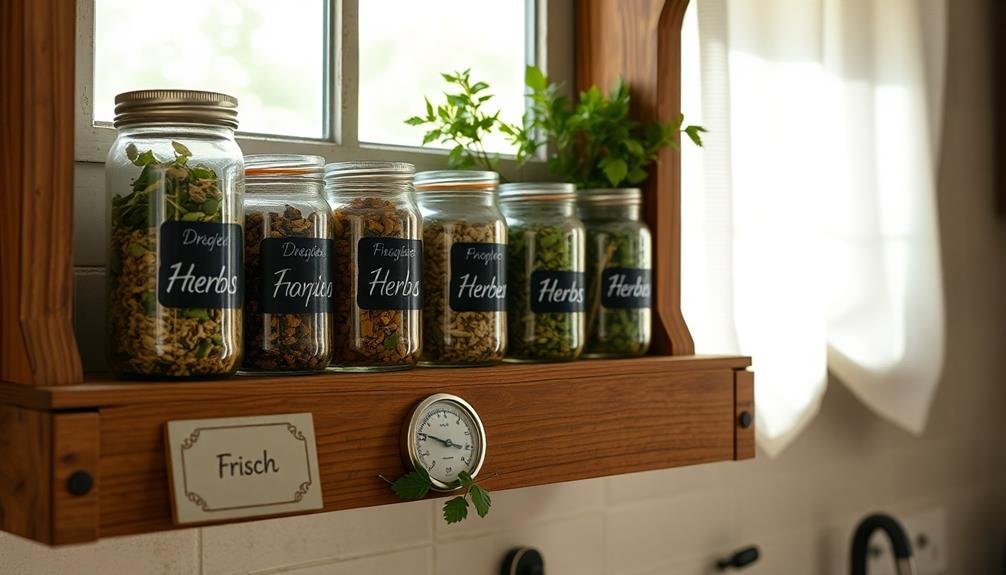



Leave a Reply